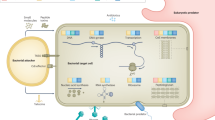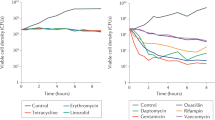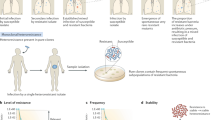Abstract
The term `microbial persistence' describes a phenomenon whereby microorganisms which are drug-susceptible when tested outside the body are nevertheless capable of surviving within the body despite intensive therapy with the appropriate antimicrobial drug. In clinical practice this phenomenon obviously has to do with the post-treatment `carrier state' and with post-treatment relapse. In short, it is this phenomenon which is responsible for our inability to eradicate an infection from a person or a community by the use of drugs. — Walsh McDermott, The Yale Journal of Biology and Medicine 30, 257 (1958).
This is a preview of subscription content, access via your institution
Access options
Subscribe to this journal
Receive 12 print issues and online access
$209.00 per year
only $17.42 per issue
Buy this article
- Purchase on Springer Link
- Instant access to full article PDF
Prices may be subject to local taxes which are calculated during checkout

Steve Horwitz
Similar content being viewed by others
References
Maher, D. & Raviglione, M.C. The global epidemic of tuberculosis: a World Health Organization perspective. in Tuberculosis and Nontuberculous Mycobacterial Infections, Fourth Edition (ed. Schlossberg, D.) 104–115 (W.B. Saunders Company, Philadelphia, 1999).
Waksman, S.A. The Conquest of Tuberculosis (Robert Hale Limited, London, 1964).
Ehrlich, P. Address in pathology on chemotherapeutics: scientific principles, methods, and results. Lancet 2, 445–451 (1913).
McCune, R.M., Tompsett, R. & McDermott, W. Fate of Mycobacterium tuberculosis in mouse tissues as determined by the microbial enumeration technique. II. The conversion of tuberculous infection to the latent state by the administration of pyrazinamide and a companion drug. J. Exp. Med. 104, 763–801 (1956).
Barclay, W.R., Ebert, R.H., Le Roy, G.V., Manthei, R.W. & Roth, L.J. Distribution and excretion of radioactive isoniazid in tuberculosis patients. JAMA 151, 1384–1388 (1953).
Clark, D.W. Genetically determined variability in acetylation and oxidation. Therapeutic implications. Drugs 29, 342–375 (1985).
McCune, R., Lee, S.H., Deuschle, K. & McDermott, W. Ineffectiveness of isoniazid in modifying the phenomenon of microbial persistence. Am. Rev. Tuberc. Pulm. Dis. 76, 1106–1109 (1957).
Jindani, A., Aber, V.R., Edwards, E.A. & Mitchison, D.A. The early bactericidal activity of drugs in patients with pulmonary tuberculosis. Am. Rev. Respir. Dis. 121, 939–949 (1980).
Mitchison, D.A. Basic mechanisms of chemotherapy. Chest 76 (Suppl.), 771–781 (1979).
Handwerger, S. & Tomasz, A. Antibiotic tolerance among clinical isolates of bacteria. Rev. Infect. Dis. 7, 368–386 (1985).
Vandiviere, H.M., Loring, W.E., Melvin, I. & Willis, S. The treated pulmonary lesion and its tubercle bacillus. The death and resurrection. Am. J. Med. Sci. 232, 30–37 (1956).
Segal, W. & Bloch, H. Biochemical differentiation of Mycobacterium tuberculosis grown in vivo and in vitro. J. Bacteriol. 72, 132–141 (1956).
McKinney, J.D. et al. Persistence of Mycobacterium tuberculosis in macrophages and mice requires the glyoxylate shunt enzyme isocitrate lyase. Nature 406, 735–738 (2000).
Sharma, V. et al. Structure of isocitrate lyase, a persistence factor of Mycobacterium tuberculosis. Nature Struct. Biol. 7, 663–668 (2000).
Ramakrishnan, L., Federspiel, N.A. & Falkow, S. Granuloma-specific expression of Mycobacterium virulence proteins from the glycine-rich PE-PGRS family. Science 288, 1436–1439 (2000).
Berthet, F.X. et al. Attenuation of virulence by disruption of the Mycobacterium tuberculosis erp gene. Science 282, 759–762 (1998).
Camacho, L.R., Ensergueix, D., Perez, E., Gicquel, B. & Guilhot, C. Identification of a virulence gene cluster of Mycobacterium tuberculosis by signature-tagged transposon mutagenesis. Mol. Microbiol. 34, 257–267 (1999).
Cox, J.S., Chen, B., McNeil, M. & Jacobs, W.R., Jr. Complex lipid determines tissue-specific replication of Mycobacterium tuberculosis in mice. Nature 402, 79–83 (1999).
Buchmeier, N. et al. A parallel intraphagosomal survival strategy shared by Mycobacterium tuberculosis and Salmonella enterica. Mol. Microbiol. 35, 1375–1382 (2000).
De Voss, J.J. et al. The salicylate-derived mycobactin siderophores of Mycobacterium tuberculosis are essential for growth in macrophages. Proc. Natl. Acad. Sci. USA 97, 1252–1257 (2000).
Manabe, Y.C., Saviola, B.J., Sun, L., Murphy, J.R. & Bishai, W.R. Attenuation of virulence in Mycobacterium tuberculosis expressing a constitutively active iron repressor. Proc. Natl. Acad. Sci. USA 96, 12844–12848 (1999).
Jackson, M. et al. Persistence and protective efficacy of a Mycobacterium tuberculosis auxotroph vaccine. Infect. Immun. 67, 2867–2873 (1999).
Hondalus, M.K. et al. Attenuation of and protection by a leucine auxotrophic mutant of Mycobacterium tuberculosis. Infect. Immun. 68, 2888–2898 (2000).
Chen, P., Ruiz, R.E., Li, Q., Silver, R.F. & Bishai, W.R. Construction and characterization of a Mycobacterium tuberculosis mutant lacking the alternate sigma factor gene, sigF. Infect. Immun. 68, 5575–5580 (2000).
Stewart, G.R. et al. Deregulation of the Hsp70 heat shock response results in reduced survival of Mycobacterium tuberculosis in the chronic phase of infection (Abstract 41). Presented at the ASM Conference on Tuberculosis: Past, Present, and Future (2000).
Asea, A et al. HSP70 stimulates cytokine production through a CD14-dependant pathway, demonstrating its dual role as a chaperone and cytokine. Nature Med. 6, 435–442 (2000).
Glickman, M.S., Cox, J.S. & Jacobs, W.R., Jr. A novel mycolic acid cyclopropane synthetase is required for cording, persistence, and virulence of Mycobacterium tuberculosis. Mol. Cell. 5, 717–727 (2000).
World Health Organization. Anti-Tuberculosis Drug Resistance in the World (World Health Organization, Geneva, 2000). Online at http://www.who.int/gtb/publications/dritw/index.htm.
Primm, T.P. et al. The stringent response of Mycobacterium tuberculosis is required for long-term survival. J. Bacteriol. 182, 4889–4898 (2000).
Stover, C.K. et al. A small-molecule nitroimidazopyran drug candidate for the treatment of tuberculosis. Nature 405, 962–966 (2000).
Alland, D. et al. Identification of differentially expressed mRNA in prokaryotic organisms by customized amplification libraries (DECAL): the effect of isoniazid on gene expression in Mycobacterium tuberculosis. Proc. Natl. Acad. Sci. USA 95, 13227–13232 (1998).
Wilson, M. et al. Exploring drug-induced alterations in gene expression in Mycobacterium tuberculosis by microarray hybridization. Proc. Natl. Acad. Sci. USA 96, 12833–12838 (1999).
Canetti, G. Present aspects of bacterial resistance in tuberculosis. Am. Rev. Respir. Dis. 92, 687–703 (1965).
Banerjee, A. et al. inhA, a gene encoding a target for isoniazid and ethionamide in Mycobacterium tuberculosis. Science 263, 227–230 (1994).
Mdluli, K. et al. Inhibition of a Mycobacterium tuberculosis β-ketoacyl ACP synthase by isoniazid. Science 280, 1607–1610 (1998).
Zimhony, O., Cox, J.S., Welch, J.T., Vilcheze, C. & Jacobs, W.R., Jr. Pyrazinamide inhibits the eukaryotic-like fatty acid synthetase I (FASI) of Mycobacterium tuberculosis. Nature Med. 6, 1043–1048 (2000).
Belanger, A.E. et al. The embAB genes of Mycobacterium avium encode an arabinosyl transferase involved in cell wall arabinan biosynthesis that is the target for the antimycobacterial drug ethambutol. Proc. Natl. Acad. Sci. USA 93, 11919–11924 (1996).
David, H.L., Takayama, K. & Goldman, D.S. Susceptibility of mycobacterial D-alanyl-D-alanine synthetase to D-cycloserine. Am. Rev. Respir. Dis. 100, 579–581 (1969).
Caceres, N.E. et al. Overexpression of the D-alanine racemase gene confers resistance to D-cycloserine in Mycobacterium smegmatis. J. Bacteriol. 179, 5046–5055 (1997).
Telenti, A. et al. Detection of rifampicin-resistance mutations in Mycobacterium tuberculosis. Lancet 341, 647–650 (1993).
Finken, M., Kirschner, P., Meier, A., Wrede, A. & Bottger, E.C. Molecular basis of streptomycin resistance in Mycobacterium tuberculosis: alterations of the ribosomal protein S12 gene and point mutations within a functional 16S ribosomal RNA pseudoknot. Mol. Microbiol. 9, 1239–1246 (1993).
Drlica, K., Malik, M., Wang, J.-Y., Levitz, R. & Burger, R.M. The fluoroquinolones as antituberculous agents. In Tuberculosis (eds. Rom, W.N. & Garay, S.) 817–827 (Little, Brown and Co., New York, 1996).
Nopponpunth, V., Sirawaraporn, W., Greene, P.J. & Santi, D.V. Cloning and expression of Mycobacterium tuberculosis and Mycobacterium leprae dihydropteroate synthase in Escherichia coli. J. Bacteriol. 181, 6814–6821 (1999).
Author information
Authors and Affiliations
Corresponding author
Rights and permissions
About this article
Cite this article
McKinney, J. In vivo veritas: The search for TB drug targets goes live. Nat Med 6, 1330–1333 (2000). https://doi.org/10.1038/82142
Issue Date:
DOI: https://doi.org/10.1038/82142
This article is cited by
-
Genetic and metabolic regulation of Mycobacterium tuberculosis acid growth arrest
Scientific Reports (2018)
-
Mycobacterium tuberculosis Rv1152 is a Novel GntR Family Transcriptional Regulator Involved in Intrinsic Vancomycin Resistance and is a Potential Vancomycin Adjuvant Target
Scientific Reports (2016)
-
Differential roles of the hemerythrin-like proteins of Mycobacterium smegmatis in hydrogen peroxide and erythromycin susceptibility
Scientific Reports (2015)
-
Using movies to analyse gene circuit dynamics in single cells
Nature Reviews Microbiology (2009)
-
Persistent bacterial infections: the interface of the pathogen and the host immune system
Nature Reviews Microbiology (2004)



